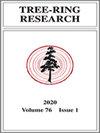集合经验模态分解作为树轮年代学发展的替代方法
IF 1.1
4区 农林科学
Q3 FORESTRY
引用次数: 9
摘要
树木年轮分析自建立以来已惠及多个科学领域。由于其诸多优点,树木年代学是重建过去环境变异性的首选方法。当前的树轮重建范式存在两个主要问题,即趋势函数的主观选择和年表生成方法对数据的保真度不足。原始的树木年轮数据一旦被去趋势化和标准化,就很难恢复。本研究引入了集合经验模态分解(EEMD)作为一种客观的高保真的独立方法来开发树木年轮年表。讨论了EEMD的基本概念、开发年表的建议步骤以及可用的公共领域程序。为了证明EEMD在年代学发展方面的潜力,提供了两个例子,一个用于气候,另一个用于河流重建。在这两个例子中,EEMD年表显示出与仪器数据更高的相关性,并且其光谱比基于当前树轮重建方法开发的年表具有更高的功率。一般的使用问题和注意事项也解决。本文章由计算机程序翻译,如有差异,请以英文原文为准。
Ensemble Empirical Mode Decomposition as an Alternative for Tree-Ring Chronology Development
Abstract Since its establishment, tree-ring analysis has benefitted several scientific fields. Because of its many advantages, dendrochronology is a first choice to reconstruct past environmental variability. Two major concerns about the current tree-ring reconstruction paradigm are the subjective choices of detrending functions and the lack of fidelity to data of chronology generation methods. It is difficult to recover the original tree-ring data once they have been detrended and standardized. In this study, ensemble empirical mode decomposition (EEMD) is introduced as an objective high-fidelity stand-alone approach for developing tree-ring chronologies. Basic concepts of EEMD, recommended steps in developing chronologies, and available public domain programs are discussed. To demonstrate the potentials of EEMD for chronology development, two examples are provided, one for climate and the other for streamflow reconstructions. In both examples, EEMD chronologies show higher correlations with the instrumental data and have more power in their spectra than the ones developed based on the current tree-ring reconstruction approach. General usage concerns and cautions are also addressed.
求助全文
通过发布文献求助,成功后即可免费获取论文全文。
去求助
来源期刊

Tree-Ring Research
农林科学-林学
CiteScore
2.40
自引率
12.50%
发文量
15
审稿时长
>36 weeks
期刊介绍:
Tree-Ring Research (TRR) is devoted to papers dealing with the growth rings of trees and the applications of tree-ring research in a wide variety of fields, including but not limited to archaeology, geology, ecology, hydrology, climatology, forestry, and botany. Papers involving research results, new techniques of data acquisition or analysis, and regional or subject-oriented reviews or syntheses are considered for publication.
Scientific papers usually fall into two main categories. Articles should not exceed 5000 words, or approximately 20 double-spaced typewritten pages, including tables, references, and an abstract of 200 words or fewer. All manuscripts submitted as Articles are reviewed by at least two referees. Research Reports, which are usually reviewed by at least one outside referee, should not exceed 1500 words or include more than two figures. Research Reports address technical developments, describe well-documented but preliminary research results, or present findings for which the Article format is not appropriate. Book or monograph Reviews of 500 words or less are also considered. Other categories of papers are occasionally published. All papers are published only in English. Abstracts of the Articles or Reports may be printed in other languages if supplied by the author(s) with English translations.
 求助内容:
求助内容: 应助结果提醒方式:
应助结果提醒方式:


